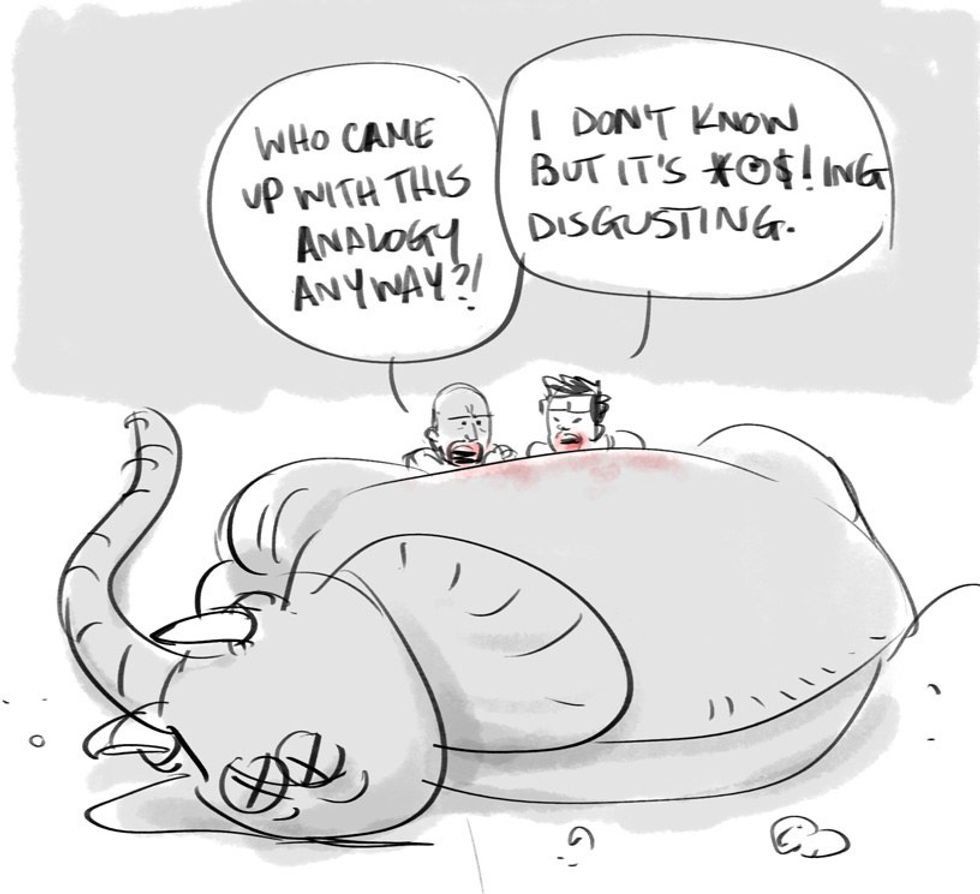Let’s talk about sex. Statistically, 34% of adolescents have had intercourse by 9th grade, and that number rises to 63% by the time they graduate high school (Eisenberg, Bernat, Resnick, Bearinger). So, most of you have had it. I want you to think back on the education provided to you by your American public school system- Do you feel accurately and fully prepared you for dealing with all the caveats of your sexualilty?
If you answered yes, you are in a lucky minority. My freshman year I had the opportunity to volunteer at Grady High School as a mentor working alongside a group that talked to at-risk teenagers about different aspects of college life, including sexuality. I was not surprised by the amount of questions they had for me surrounding sex in the new freedom of college life. What I was surprised by was how much basic information they had not been taught. Out of a group of 15 students that I worked with, around 8 of them believed that HIV was only transmitted by vaginal intercourse, and at least 6 of them could not name more than two types of birth control, let alone how they could access it. Most of their information had clearly come from questions to their friends, or other inconsistent sources. I overheard one 15 year old girl tell her friend that she never used condoms because her older sister told her it wasn’t “fun for the guy”. I found myself in a state of awe at how badly these teenagers had been informed on sexual health, and wondering if this was the level of education that most of the country was giving their adolescents. Unfortunately, what I found out was that this group of teenagers had been subject to the widespread political, religious, and old-fashioned sexual education barriers that still exist in much of the United States today, and that they represented the much bigger problem. The United States treatment of sexual education in public schools is less than ideal, and needs to be reformed to a more comprehensive and inclusive curriculum that is implemented across the board.
Before we can discuss the state of sexual education in schools today, we must first see how we got here. In Natasha DiGenio’s Censorship Authority in Sex Education in the American Educational History Journal , she discusses the change from the sexual revolution in the 1960s and into the 1970s, and the furthering of education from the 1950’s nuclear family ideals. After World War II, sexuality was brought out into the public sphere more and more, and with the invention of the birth control pill, the United States experienced a sexual revolution where for the first time youth was being taught proper sexual education. Straying away from the 1950’s education based fully on the “darkside” of sexuality (STD’s, sickness, and death), curriculum began to include contraception options and using previously socially unacceptable, but scientifically accurate, vocabulary such as “orgasm” and “vagina”. So what happened between then and now to our education system? Although this revolution was a positive move for sex education, both political and religious conservatives were vehemently opposed to it. They were convinced that teaching more about sex would encourage adolescents to become sexually active, leading to problems such as teenage pregnancy, and the issues such as widespread aids in the 80s. This lead to a shift in the late nineties that partially withstands today- one that focuses on abstinence education that purposefully leaves out “controversial” topics concerning sexual health.
The State of Sex Education in the United States in the Journal of Adolescent Health outlines these shifts and a provides a look at today’s sexual education system. In the nineties, as a part of Welfare reform, AOUM was created. AOUM stood for “abstinence only until marriage”, and was funded by the US government. It was immediately integrated into 49/50 US states, and although it seems like an outdated group, is still funded by our government today. Although Obama’s administration fought against it, a conservative win allowed an $85 million dollar a year increase for AOUM in the 2016 budget. This is not an end-all, be-all problem for comprehensive education, however, because in the United States, state governments and school boards determine their own sexual education curriculum. However, the statistics for these state curriculums are just as worrying. 37 states currently require abstinence training, but only 33 require birth control information, and only 18 require coverage on HIV. Even more shocking is that only 8 are required to be inclusive of sexual orientations outside the heteronormative, and only 2 must separate their sexual education from any religious ideals. (Guttmacher Institute) These startling statistics reflect the ideals of many abstinence only education plans.
Now that you understand what the United States curriculum looks like, you might ask yourself- why is it so bad to have education centered on abstinence? The answer becomes apparent through the understanding of the details of this system. Katherine Carroll in Children’s Lives as a Political Battleground: The Plague of Abstinence Only Education in the DePaul Journal for social Justicedescribes the unhelpful climate created by this curriculum. In most cases, abstinence only education is required to include and not include certain things. For example, many include value judgements that line up with old fashioned or religious ideals, such as marriage being essential to human sexuality. Most do not include any form of birth control information, and instead employ fear tactics to scare adolescents away from sexual activity, using quotes like “Nature seems to be making a statement about the wisdom of keeping sex within marriage through the current epidemic of sexually transmitted diseases and teen pregnancy.” (Arndorfer, Carroll) Besides providing biased and often inaccurate information (some even going so far as to use fake statistics, such as saying that condoms preventing STI’s isn’t proven fact), Carroll points out that the fear of conservatives that comprehensive education is the antithesis of abstinence is false. In fact, no one wants to encourage sexual behaviors in young adults. What comprehensive education would provide is some information on the option of abstinence, but also information on everything else accompanying sexuality, therefore leaving it up to an individual how they deal with their budding sexuality, and giving them the information and tools to make an informed decision that works for them. Similarly, the argument of conservatives that the numbers of sexually active teenagers is higher because of comprehensive sex ed is false- The American Academy of Pediatrics Committee on Adolescence found that sexual education that discusses contraception has no correlation with an increase in sexual activity. (Klein) Another source found that there are the same number of teens having sex today that there was 20 years ago (Zimlich). It seems that no matter how much the scientific community provides information on comprehensive sexual education, political and religious agendas outweigh the data.
We are the ones who must combat this trend in ineffective and abstinence centered education. We know that this system is ineffective and detrimental to our youth, and we have learned that abstinence only education plans are harmful and need to be changed to more comprehensive educational curriculum in our public schools. We have the power to put those in political office who support comprehensive sexual education and diminish outdated and ineffective programs such as AOUM. Some scholars, such as Rachel Zimlich in the Journal of Contemporary Pediatrics, suggest that following guidelines of the health community, such as the CDC and pediatricians, is essential to the reformation in schools. We must also encourage parents to participate in open dialogue with their children to supplement the education in schools. But above all, we must lobby for the end of abstinence only education to keep rates of disease and pregnancy down in our adolescents, such as in the group of high schoolers I worked with. After all, in the words of the Henry J Kaiser Family Foundation, “Vows of abstinence break far more easily than latex condoms.” (Carroll)
References:
Carroll, Katherine. "Children's Lives as Political Battlegrounds: The Plague of Abstinence Only Education." DePaul Journal for Social Justice Fall 2009 3.1 (2009): 41-77. Web. 20 Oct. 2016.
DiGenio, Natasha. "Censorship and Authority in Sex Education." American Educational History Journal 43.2 (2008): 225-40. Web. 18 Oct. 2016.
Eisenberg, Marla E., Debra H. Bernat, Linda H. Bearinger, and Michael D. Resnick. "Support for Comprehensive Sexuality Education: Perspectives from Parents of School-Age Youth." Journal of Adolescent Health 42.4 (2008): 352-59. Web. 18 Oct. 2016.
Hall, Kelli Stidham, Jessica Mcdermott Sales, Kelli A. Komro, and John Santelli. "The State of Sex Education in the United States." Journal of Adolescent Health 58.6 (2016): 595-97. Web. 19 Oct. 2016.
Klein, J. D. "Adolescent Pregnancy: Current Trends and Issues." Pediatrics 116.1 (2005): 281-86. Web.
Zimlich, Rachel. "How to Fill Gaps in Sexual Health Education." Contemporary OB/GYN May 2016 (2016): 35-37. Web. 19 Oct. 2016.





 Photo by
Photo by  Photo by
Photo by 
 Photo by
Photo by 


















